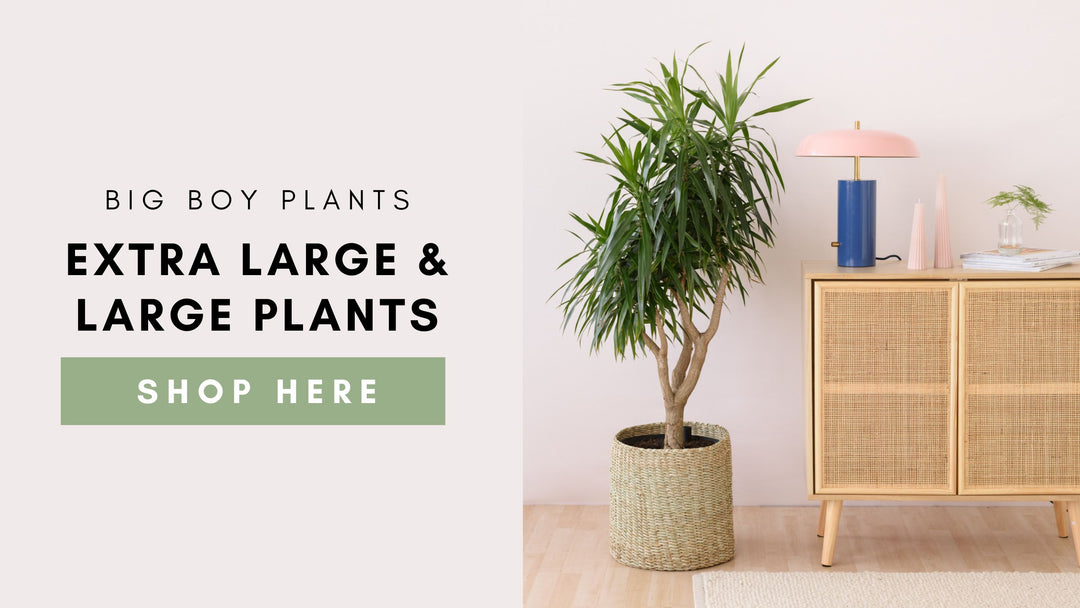Money Tree Care Instructions
Scientific name: Pachira Aquatica
Synonyms: Chinese Money Tree, Money Tree, Guiana Chestnut, Japanese MoneyTree, Shaving-brush Tree, Malabar Chestnut, Water Chestnut, Saba Nut, Fortune Tree, Feng shui Money Plant.
The Chinese Money Tree is a definite must-have indoor tree variety, not only for its lush palmate foliage and delicately braided stems, but also for its mystical properties of luck and prosperity. It is said that under Feng shui, if placed in the correct position, it will bring your home or workspace good energy and positivity. This makes them a wonderful housewarming gift full of good fortune.
Pachira Aquatica are tolerant of a wide variety of lighting conditions, and will happily grow in lower light if need be. Best started off young they make for a tasteful tabletop specimen, that in time will grow tall with an average indoor height of around 2m. Creating a statement as an impactful indoor tree.
Endemic to Central and South America often found in wetlands and on river banks, owing to its name (Pachira Aquatica) it loves moist soil. Though, its origins are damp areas, water is not a must to keep this plant thriving. This trait makes the Money Tree an ideal houseplant for beginners.
Note: The Pachira Aquatica is not considered toxic.

Money Tree Common Symptoms
- Crisp foliage or drooping leaves: This is an indication of underwatering, especially if the leaves are looking pale and lacklustre or excessive droop has set in. Check the soil, and if it is extremely dry, adjust your watering needs to a more frequent rotation. Pachira in general can tolerate short bouts of dryness but should be kept consistently evenly moist for best results. If your soil is moist but crisp foliage still appears, up the humidity as your air may be a little too dry. This can be achieved by placing your plant on a pebble tray. Click for more on Identifying Under vs Overwatering.
- Yellowing leaves: There are a few factors that can cause yellowing foliage on your houseplant, often overwatering is cited as being the main culprit. However, if you find that leaves turn yellow infrequently, this is not a cause for concern as this is the natural lifecycle of most houseplants, though if yellowing happens on mass consider your watering regime. Chinese Money trees love moist soil but if the soil stays overly saturated this can cause root rot, resulting in yellowing foliage. If you discover your watering regime is fine, it may be that your plants may be under fertilized, feed with a well-balanced liquid houseplant feed regularly, and you should see an improvement.
- Leaf drop: This could be caused by a multitude of reasons, the main either being overwatering, underwatering or over relocation. If you have ruled out both over and underwatering, then consider how often you have changed the plant’s position. Money trees prefer to be left in the same location and get accustomed to their positioning, and if you often move them around or yourself have done a major move, from one home to another, leaf drop can occur from the environmental changes. It is best to choose a bright filtered light position and leave the plant in its allotted space, and in time it should recover and regrow its leaves.
- Pests: Pachira Aquatica can be susceptible to pests if care is not taken to keep your plant in its optimal conditions, and allowing stress to occur. This will lead to pest infestations causing excessive yellowing fronds and leaf drop. Mealybug, scale and spider mites are common indoor plant pests and can weaken your plant relatively quickly if left untreated. Adjust environmental stressors for your house plant and treat infestations with an organic pesticide or neem based oil. Click for more on Identifying Pests.
Money Tree Care Instructions
- Origin: Central and South America
- Height: Averaging 5m in height
- Light: Thrives in bright filtered light, some soft sun is beneficial but be sure to avoid direct midday sun which can scorch the foliage. Will tolerate lower light, however, will grow at a slower rate.
- Water: Keep the soil evenly moist as best as possible; avoid prolonged periods of drying out.
- Humidity: Average to high humidity.
- Temperature: Ideal temperatures range from 18°C - 26°C.
- Soil: A well-draining, slightly moisture retentive organic potting soil is sufficient.
- Fertilizer: Use a well balanced organic plant fertilizer once a month from Spring through Summer. Click for more on how to Fertilize Houseplants.
- Repotting: These are fast-growing specimens and whilst young may need regular yearly maintenance, however as they mature they prefer bi-yearly transplantation as they do not like their roots overly disturbed. Repot once growth has slowed or your plant has become rootbound. Choose a planter no larger than 5cm wider than the previous, and plant into a well-draining, aerated mix, consisting of milled bark or perlite for extra drainage.
- Propagation: This can be achieved via cuttings. It is best to take your cutting during the morning when temperatures are at their coolest. Select a healthy branch with new growth and snip off about 10 -15cm using a sharp sterilized cutting utensil, making sure you have two to three leaf nodes, as this is where the new roots will shoot from. Pop into some water at a depth of 2cm and change the water regularly. Once a root system of approximately 5 - 6cm has developed, gently pot up your cutting into a well-draining, moisture-retentive mix. Place in a bright warm spot and once new growth has started, your plant is established.
If in stock, shop for a Chinese Money Tree here



